 |
| Jeepney in a crowded street, Cavite Province, Philippines |
Heat. Humidity. Suffocation from carbon monoxide poisoning, with death or injury just an arm's length away as cars and tricycles and the ever colorful jeepneys zoom past me on narrow roads with no sidewalks.
Welcome to my first botanical expedition on the streets of Cavite Province in the Philippines.
I won't be here long, and I am otherwise busy, but I made it a point to walk the streets of the town I was in on the third day of my stay. I was excited to see what kinds of grasses thrived in this disturbed tropical urbanized area.
Of course some grasses are so successful that what I see in New Jersey (or Florida) also makes its home in this tropical location halfway around the world, and I wasn't disappointed.
In the home I am staying in, a new cluster of Imperata cylindrica (called kogon locally) has started dominating a side lawn, shading out the turf grasses and engulfing an ornamental plant. I caressed the long blade-like leaves, feeling the sharp edges and feeling almost proprietary towards this globe-trotting tropical invader. It's native to this country, but just as aggressive and dominant. In fact, it is so dominant that people here call the vast grasslands covered in this species "kogonales".
 |
| Imperata cylindrica - showing who's the boss |
Once I stepped out of the home, a thriving colony of Dactyloctenium aegyptium (called damung-balang here) greeted me, their rather pretty inflorescence quite easy to identify. I have seen this same plant thriving in the heat in south Florida, and here it is a ubiquitous grass. In fact, it is one of the top weeds in vegetable and rice gardens, although it is native.
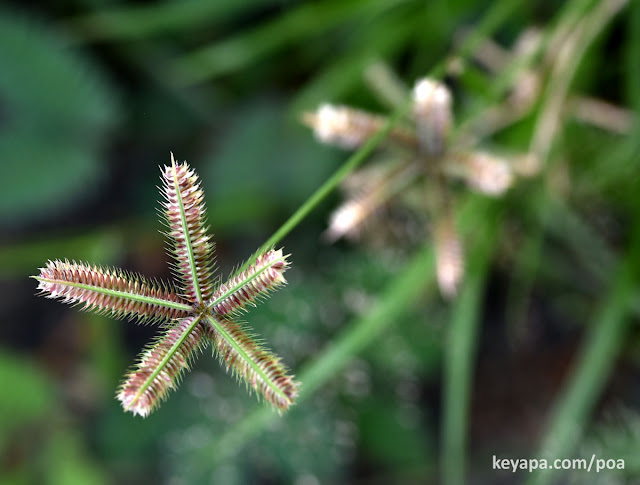 |
Dactyloctenium aegyptium - digitate inflorescence
|
The next grass I saw as I walked the suburban streets was one that at least was not in the USA. It had digitate inflorescence and strikingly enough, a row of encircling white hairs on some nodes! I typed it later as a
Dichanthium spp, perhaps
Dichanthium annulatum (called "lindi" here). It is naturalized in the area and probably came between 1945 and 1950s as a potential forage. Of course it escaped and is now probably found all over.
 |
| Dichanthium annulatum - inflorescence |
 |
| Dichanthium annulatum - ring of white hairs around node |
 |
| Dichanthium annulatum - ligule and white hairs |
 |
| Dichanthium annulatum |
I then entered a main road, vehicles whizzing past me close enough to feel the wind of their passing, and I encountered an individual flowering specimen that I at first thought I had last seen in the Nature Conservancy's Disney Wilderness Preserve in Florida. It had the same digitate inflorescence that seemed to curl inwards, and I was thinking it was Eustachys petraea. But looking later at lists of Philippines grasses, it is probably Chloris barbata.
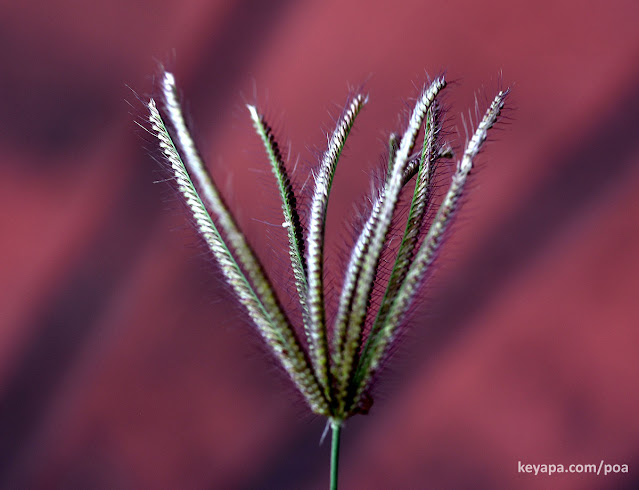 |
| Chloris barbata? - digitate inflorescence |
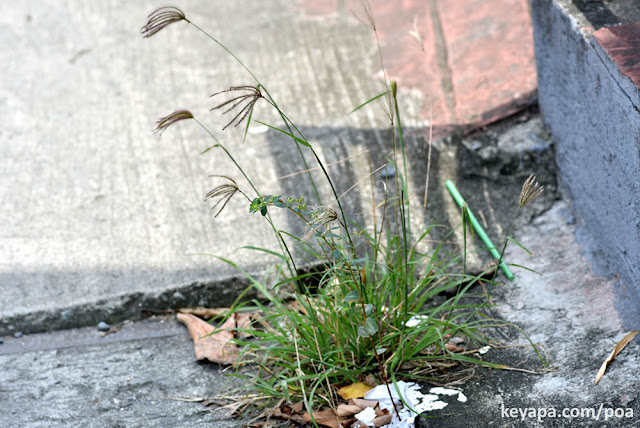 |
| Chloris barbata?- habit |
On the sides of the main road were various stores and private residences (there does not seem to be any zoning going on obviously), and as I passed one home I noticed that a fine bladed grass had crawled up the side of a stone wall, using the cracks in the wall as its path. The specimen was stoloniferous, and had tiny spike-like inflorescence jutting out of the mass of blades at various points.
 |
| Zoysia matrella cliimbs up a wall |
 |
| Zoysia matrella - the specimen had lots of spike like inflorescence |
A quick inspection showed that it was a turf grass that had moseyed out of the home's lawn. I was thinking it looked slightly like Eremochloa ophiuroides (centipedegrass in the USA), another turf grass which I had profiled in an earlier post. But further study typed it as from the genus Zoysia, perhaps Zoysia matrella.
This turfgrass genus is also an inhabitant of the lawns in the warmer parts of the USA, and I was not surprised to find it here as well.
 |
| Zoysia matrella - inflorescence with purple stigmas and yellow anthers |
An old "friend" made an acquaintance as I continued along the road. I encountered specimens of Eleusine indica (called "paragis" here, as well as a LONG list of other common names due to the different dialects and languages in the country), the unmistakable inflorescence and white center a dead give-away for this ubiquitous weed. It has become naturalized in the country, and it is just as much of a pest here as in many other countries in the world.
 |
| Eleusine indica - inflorescence |
 |
| Eleusine indica - white center |
On the way home after ranging perhaps 0.5 km along the narrow dusty road, I stopped by a convenience store called Alfamart, and by chance happened upon a cluster of grasses that were living beneath the shade of a tired palm. The specimens were in flower, and the spikelets on the spike-like inflorescence reminded me of the sandbur (Cenchrus longispinus) that I had profiled in the USA.
 |
| Cenchrus brownii - habit |
Each spikelet had silvery white stigmas peeking out of the purple tinged spines, and in this case, I typed the species to perhaps Cenchrus brownii or Cenchrus echinatus. Both are native to the Americas but have become naturalized in the Philippines, and both are inhabitants of open waste spaces and other disturbed areas.
 |
| Cenchrus brownii - inflorescence with spikelets (and white stigmas) |
 |
| Cenchrus brownii - inflorescence with spikelets |
The spines on the spikelet function to attach to passing traffic, allowing the grass seeds to hitchhike using passersby. Unfortunately, the spines are also quite sharp and can pierce the skin (much to the horror of beachgoers everywhere with their bare feet), and I made the mistake of storing an inflorescence in my camera bag and later getting spiked when I reached into the bag! Definitely painful!
 |
| Cenchrus seedhead attaching to unfortunate cameraman |
Finally, I saw one particularly tiny grass that seemed to crop up sporadically all over, whether in decrepit lawns, or cracks in the road. This particular species had fine panicles, and I was thinking that it was the notorious Poa annua, one of the most widespread grasses in the planet and one that is even threatening the ecology in far away Antarctica!
But a closer inspection revealed some discrepancies. For one thing, the spikelets seemed much smaller than those I had typed as P. annua in the USA (on the order of only 1-2 mm long at most). Nor were the tips of the leaf blades folded and boat like, and I did not find any long ligule at the blade junctions, a diagnostic characteristic of the species. In addition, the long hairs near the ligule did not seem to be present in P. annua. I am left with a mystery, but what is life without the added incentive of such goals? I can only hope that one day I will be pointed in the right direction. Below are images of the so far unknown (but very ubiquitous here) species.

Macros of the extremely tiny spikelets (note the dark red-brown seeds in some):
I have to say that the ability of many grasses to spread and colonize far away lands was on full display during this first botanical jaunt that I did. Fully half of the species I encountered were those that I had already encountered in the USA, half a world away! Of course the count was biased by the fact I limited my tour to a semi urban environment, which usually housed cosmopolitan disturbance specialists. But I was impressed anyways.
Urban botanizing is not for the faint of heart in this town, what with the narrow roads with no sidewalks, and the allegedly rampant holdups (especially when one is lugging around relatively expensive stuff like a DSLR camera with a large macro lens). In this first botanical expedition in the heart of a bustling town in Cavite, Philippines, I did not cover a lot of ground (perhaps 0.5 km at most away from the house), but the diversity of grasses was still a pleasant surprise. I thoroughly enjoyed it, and will do a few more before the end of my stay.
























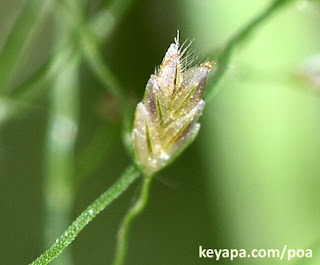



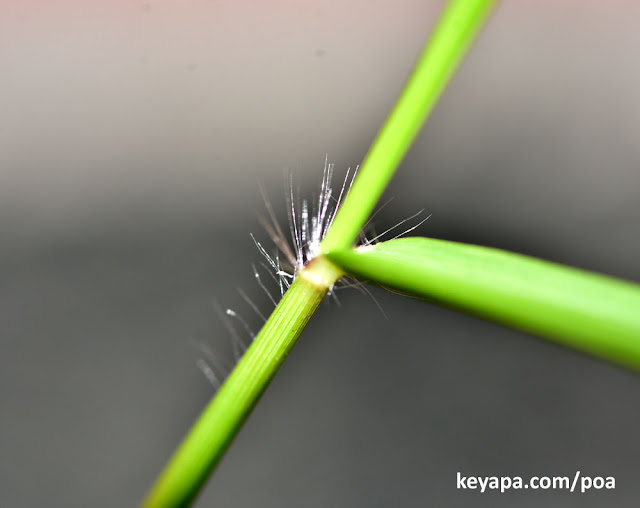



2 comments:
Very interesting ! But I wonder if that is D aristatum rather than D. annulatum ? - I dont know either well but the former apparently has wooly nodes and hairs at the base of the inflorescence. D. aristatum is also naturalised in parts of N Australia as is Indian couch Bothriochloa pertusa. B. pertusa looks similar but has aromatic leaves- it now forms monocultures in some areas having colonised whole paddocks left bare by overgrazing and drought.
Not sure about Bothriochloa pertusa, but if you look at this page, it seems the bases of the branches of D. annulatum have no hairs, whereas those of D. aristatum is hairy. I checked to make sure, and the specimens I took definitely have non hairy bases. Both species have wooly nodes.
http://floranorthamerica.org/Dichanthium_aristatum
Post a Comment